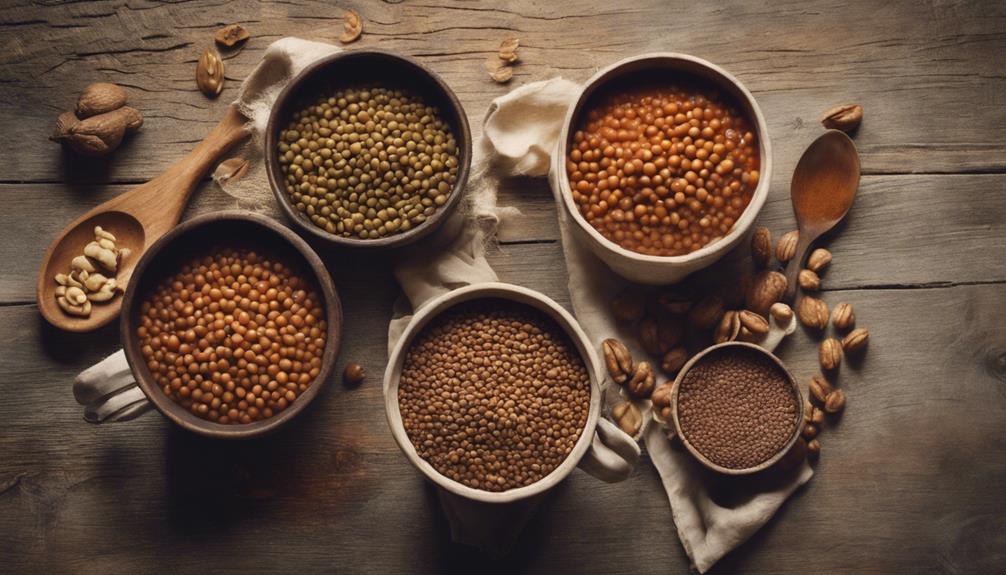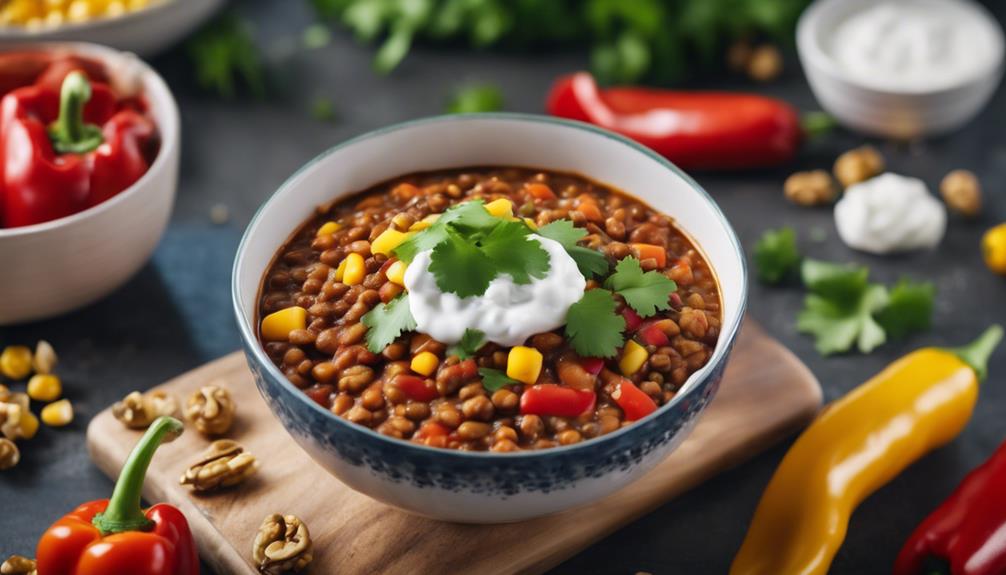Vegetarian Lentil and Walnut Chili
For a wholesome and tasty meal, try making vegetarian lentil and walnut chili. Lentils, packed with protein and fiber, provide a nutritious base. Incorporate walnuts for a meaty texture and extra flavor. Season with staples like cumin and chili powder, adding depth. Toast the walnuts for a satisfying crunch. Explore thickening methods such as cornstarch or simmering for a rich consistency. Enhance the dish with blended vegetables for added nutrition and texture. Discover the secrets to a scrumptious vegetarian chili. More culinary insights await your exploration.
What You Will Learn Here
- Lentils provide protein and texture.
- Toasted walnuts add crunch and flavor.
- Incorporate spices for depth.
- Simmer slowly for rich taste.
- Blend in vegetables for added nutrition.
Lentil's Culinary Journey

Lentils have come a long way in their culinary journey, offering a plethora of nutritional benefits like being rich in protein and fiber.
Their versatility in cooking allows them to be used in various dishes, from soups and stews to salads and curries.
Lentils also hold cultural significance in many cuisines worldwide, showcasing their adaptability and popularity in diverse culinary traditions.
Lentils' Nutritional Benefits
Exploring the nutritional benefits of lentils reveals a wealth of essential nutrients that contribute to their prominence in culinary traditions worldwide. Lentils are nutrient-packed legumes known for their high protein content, making them a valuable addition to vegetarian and vegan diets. Lentils provide a plant-based source of protein, essential for muscle repair and growth.
In addition to protein, lentils are rich in fiber, aiding in digestion and promoting gut health. These legumes are also a good source of iron, which is vital for transporting oxygen in the body and preventing fatigue. Lentils contain folate, a B vitamin important for cell division and overall health.
With their low glycemic index, lentils help regulate blood sugar levels, making them an excellent choice for individuals managing diabetes or looking to stabilize energy levels throughout the day. Incorporating lentils into your meals can enhance their nutritional value, providing a hearty and satisfying option for those seeking a balanced diet.
Whether in soups, salads, or chilis, lentils offer a versatile and nutritious ingredient to support your health and well-being.
Versatility in Cooking
To truly appreciate the culinary journey of lentils, consider how their versatility in cooking opens up a world of creative possibilities in the kitchen. Lentils are incredibly adaptable, allowing for various ingredient substitutions and flavor experimentation. You can swap different types of lentils depending on what you have on hand, or substitute them for other legumes like chickpeas or beans in recipes. When it comes to flavor, lentils can absorb a wide range of spices and seasonings, making them perfect for trying out new taste combinations.
Incorporating different cooking techniques can also enhance the versatility of lentils. From simmering them in soups and stews to roasting them for added texture, there are numerous ways to prepare lentils to suit your culinary needs. Additionally, time-saving tips like pre-soaking lentils or using a pressure cooker can help streamline the cooking process without compromising on flavor. Experimenting with these techniques can elevate your dishes and introduce new dimensions to your meals.
Cultural Significance
What cultural traditions have lentils influenced in the culinary world?
Lentils have a rich history of cultural influences and have become a staple in many global cuisines. Their versatility and nutritional benefits have made them a cornerstone of plant-based diets, catering to the growing popularity of vegetarian lifestyles worldwide.
In Indian cuisine, lentils are a key component in dishes like dal, providing a good source of protein for those who don't consume meat. Similarly, in the Mediterranean region, lentils are used in hearty soups and stews, adding depth and substance to meals.
The adaptability of lentils has allowed them to seamlessly integrate into various cultural culinary practices, offering a reliable source of nutrients and flavor. As plant-based diets gain traction for both health and environmental reasons, lentils continue to play a significant role in providing essential nutrients while supporting sustainable food choices.
Whether in traditional recipes or innovative dishes, lentils have woven themselves into the fabric of global cuisine, showcasing their cultural significance and culinary versatility.
Key Pantry Staples
Stock up your pantry with essential ingredients for creating flavorful vegetarian dishes like this chili, ensuring you're always ready to cook up a delicious meal. Here are four key pantry staples to have on hand for preparing hearty and nutritious meals:
- Lentils: These versatile legumes are a fantastic vegetarian protein source and work well in chilis, soups, and salads. They're packed with fiber and essential nutrients, making them a pantry must-have for meat alternatives.
- Canned Tomatoes: Whether whole, diced, or crushed, canned tomatoes are a pantry powerhouse for adding depth and richness to vegetarian dishes like chili. They're convenient and provide a burst of flavor to any meal.
- Walnuts: A great meat alternative, walnuts are rich in omega-3 fatty acids and add a satisfying crunch to dishes like vegetarian chili. They're also a versatile ingredient for making walnut-based sauces and spreads.
- Spices (like cumin, chili powder, and smoked paprika): Building a collection of spices is essential for adding layers of flavor to vegetarian dishes. These spices are perfect for creating a robust seasoning profile in your chili and other plant-based meals.
Chili Con Carne Variations

When it comes to Chili Con Carne variations, you have some delicious options to explore.
Consider trying out the Walnut Lentil Chili for a unique twist, or maybe go for the Walnut-Lentil Fusion Chili for a flavorful blend.
And if you're feeling adventurous, why not give the Spicy Lentil Walnut Stew a go for a kick of heat and texture.
Walnut Lentil Chili
To add a delightful twist to your chili con carne repertoire, consider trying out a Walnut Lentil Chili variation.
- Flavorful pairings: The earthy taste of lentils and the nuttiness of walnuts complement the rich flavors of traditional chili spices, creating a unique and satisfying dish.
- Cooking techniques: Incorporating lentils and walnuts into your chili involves simmering them with the other ingredients to allow the flavors to meld together. The lentils add a hearty texture, while the walnuts bring a crunchy element to each bite.
- Nutritional benefits: This variation not only adds depth to the flavor profile but also boosts the nutritional value of the dish. Lentils are a great source of plant-based protein and fiber, while walnuts provide healthy fats and additional protein.
- Versatility: Walnut Lentil Chili can be enjoyed on its own, served over rice, or with a side of crusty bread for a wholesome and satisfying meal that will please vegetarians and meat-eaters alike.
Walnut-Lentil Fusion Chili
For a tantalizing fusion of flavors and textures in your chili repertoire, consider exploring the Walnut-Lentil Fusion Chili variation. This innovative take on chili combines the earthy richness of walnuts with the hearty goodness of lentils, creating a dish that's both satisfying and nutritious.
Here are some pointers to get you started:
- Walnut pairing, flavor profiles: Walnuts add a unique crunch and nuttiness to the chili, enhancing its overall taste and texture.
- Lentil substitutions, protein sources: Lentils are an excellent plant-based protein source that can easily replace meat in chili recipes, offering a hearty and filling alternative.
- Experiment with different types of lentils such as green or black lentils to vary the texture and flavor profile of your chili.
- Consider adding a variety of spices and herbs to elevate the flavor profile of your Walnut-Lentil Fusion Chili, such as cumin, smoked paprika, and fresh cilantro.
Spicy Lentil Walnut Stew
Blending spicy lentils with crunchy walnuts creates a flavorful twist on traditional chili con carne in this hearty stew variation. This Spicy Lentil Walnut Stew offers a unique flavor profile that combines the earthiness of lentils with the nuttiness of walnuts, creating a satisfying and filling dish.
To achieve the perfect balance of flavors and textures, consider the following:
- Toasting the Walnuts: Toasting the walnuts before adding them to the stew enhances their crunchiness and deepens their flavor, adding a rich nuttiness to the dish.
- Layering Spices: Incorporating layers of spices like cumin, chili powder, and smoked paprika allows the flavors to meld together over low heat, intensifying the overall taste of the stew.
- Simmering Slowly: Allowing the stew to simmer slowly on the stovetop helps the lentils absorb the spices and broth, resulting in a rich and well-developed flavor profile.
- Balancing Heat: Adjusting the amount of spicy elements, such as jalapeños or cayenne pepper, can help tailor the heat level to your preference without overpowering the other flavors in the dish.
Chili Thickening Techniques
To thicken your chili, consider using cornstarch, simmering the mixture to reduce the liquid, and blending in vegetables for added texture and richness.
Cornstarch acts as a reliable thickening agent, while simmering helps concentrate the flavors and thickens the chili naturally.
Incorporating pureed vegetables not only boosts the nutritional value but also contributes to a heartier consistency in your dish.
Cornstarch for Thickening
Consider incorporating cornstarch into your vegetarian lentil and walnut chili for a thicker consistency. Cornstarch is a versatile thickening agent that can help guarantee the texture of your chili. If you're looking for cornstarch alternatives, arrowroot powder or tapioca starch can also be used in place of cornstarch. When using cornstarch, mix it with a cold liquid before adding it to your chili to prevent clumping. This method guarantees a smooth incorporation of the cornstarch into the dish.
To experiment with flavors while thickening your chili, consider adding spices like cumin or smoked paprika to the cornstarch mixture. These additions can enhance the overall taste of your chili while helping it achieve the desired thickness. Remember to adjust the seasoning accordingly to maintain a balanced flavor profile.
Incorporating cornstarch or its alternatives into your vegetarian lentil and walnut chili can be a simple yet effective way to achieve the desired thickness. By following these thickening tips and making recipe modifications, you can create a hearty and flavorful chili that's sure to impress.
Simmer to Reduce
To further enhance the thickness of your vegetarian lentil and walnut chili, simmering the mixture to reduce its liquid content can intensify flavors and create a rich, hearty texture. By allowing the chili to simmer over low heat for an extended period, the liquid in the recipe evaporates, concentrating the flavors and thickening the overall consistency. This slow cooking technique not only reduces the liquid content but also allows the ingredients to meld together, resulting in a more robust and flavorful dish.
During the simmering process, make sure to stir occasionally to prevent the chili from sticking to the bottom of the pot. As the liquid reduces, the chili will naturally thicken, achieving a satisfying texture. Additionally, the simmering allows the flavorful seasonings to permeate the dish, enhancing the taste profile of your vegetarian chili.
Blend in Vegetables
For a heartier texture and added depth of flavor, incorporate a variety of vegetables into your vegetarian lentil and walnut chili. Vegetable incorporation not only boosts the nutritional value of your chili but also enhances its overall taste profile. Consider adding diced bell peppers, carrots, onions, and tomatoes to your chili for a colorful and flavorful mix.
When blending in vegetables, aim to chop them into small, uniform pieces to guarantee even cooking and distribution of flavors throughout the chili. Sautéing these vegetables before adding them to the chili can help bring out their natural sweetness and deepen the overall taste of the dish.
Final Thoughts

Reflecting on the hearty flavors and nourishing ingredients of this vegetarian lentil and walnut chili, you can't help but appreciate its versatility and comforting appeal. The dish's rich blend of spices, protein-packed lentils, and crunchy walnuts creates a satisfying meal that's both wholesome and delicious. As you consider the experience of making and enjoying this chili, you might find yourself thinking about how you could customize it to suit your preferences in the future.
In terms of reflections, you may find that adjusting the spice levels to your liking or experimenting with different types of beans could offer exciting variations to this recipe. Additionally, adding more vegetables like bell peppers or zucchini can enhance the nutritional value and textures of the chili. Considering future modifications, you could also explore incorporating alternative plant-based proteins such as chickpeas or tofu to cater to different dietary needs or tastes. Overall, this vegetarian lentil and walnut chili serves as a wonderful base for culinary creativity and nourishing meals.
Frequently Asked Questions
Can I Substitute Lentils With Another Type of Bean in the Chili?
You can substitute lentils with another type of bean in the chili. Black beans or kidney beans work well. Experiment with different beans for a variety of flavors. Remember to adjust cooking time accordingly for best results.
How Can I Make the Chili Spicier for More Heat?
To make the chili spicier for more heat, try adding jalapenos or cayenne for an extra kick. You can also top it off with spicy condiments like hot sauce or chili flakes to turn up the heat level.
Is It Possible to Make This Chili in a Slow Cooker?
Yes, you can make this chili in a slow cooker. Slow cooker benefits include convenience and enhanced flavors. Cooking techniques involve layering ingredients and adjusting cook times. Your vegetarian chili will be deliciously hearty and satisfying.
Can I Freeze the Leftover Chili for Later Consumption?
Yes, you can freeze leftover chili for later consumption. To guarantee freshness, store it in airtight containers or freezer bags. When reheating, thaw in the fridge overnight or use the microwave. Enjoy your delicious chili whenever you crave it!
Are There Any Recommended Side Dishes to Serve With This Chili?
Sure, you can pair your chili with various salads like a fresh green salad or a tangy coleslaw. Bread options such as cornbread or crusty rolls complement it well. For beverages, try a crisp beer or a fruity iced tea. Consider finishing with a sweet treat like brownies or fruit sorbet.
Conclusion
To sum up, vegetarian lentil and walnut chili is a delicious and hearty alternative to traditional meat-based chilis. With the right pantry staples and thickening techniques, you can create a flavorful dish that's both nutritious and satisfying.
Whether you're a vegetarian or simply looking to switch up your chili game, this recipe is sure to please your taste buds. Give it a try and enjoy a warm bowl of comfort on a chilly evening.











